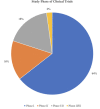Gene therapies for high-grade gliomas: from the bench to the bedside
- PMID: 32608374
- PMCID: PMC7975827
- DOI: 10.23750/abm.v91i7-S.9953
Gene therapies for high-grade gliomas: from the bench to the bedside
Abstract
Background: Gene therapy is the most attractive therapeutic approach against high-grade gliomas (HGGs). This is because of its theoretical capability to rework gene makeup in order to yield oncolytic effects. However, some factors still limit the upgrade of these therapies at a clinical level of evidence. We report an overview of glioblastoma gene therapies, mainly focused on the rationale, classification, advances and translational challenges.
Methods: An extensive review of the online literature on gene therapy for HGGs was carried out. The PubMed/MEDLINE and ClinicalTrials.gov websites were the main sources. Articles in English published in the last five years were sorted according to the best match with the multiple relevant keywords chosen. A descriptive analysis of the clinical trials was also reported.
Results: A total of 85 articles and 45 clinical trials were selected. The main types of gene therapies are the suicide gene, tumor suppressor gene, immunomodulatory gene and oncolytic therapies (virotherapies). The transfer of genetic material entails replication-deficient and replication-competent oncolytic viruses and nanoparticles, such as liposomes and cationic polymers, each of them having advantages and drawbacks. Forty-eight clinical trials were collected, mostly phase I/II.
Conclusion: Gene therapies constitute a promising approach against HGGs. The selection of new and more effective target genes, the implementation of gene-delivery vectors capable of greater and safer spreading capacity, and the optimization of the administration routes constitute the main translational challenges of this approach.
Conflict of interest statement
Each author declares that he or she has no commercial associations (e.g. consultancies, stock ownership, equity interest, patent/licensing arrangement etc.) that might pose a conflict of interest in connection with the submitted article
Figures
References
-
- Jiang T, Mao Y, Ma W, et al. CGCG clinical practice guidelines for the management of adult diffuse gliomas. Cancer Lett. 2016;375(2):263–273. https://doi.org/10.1016/j.canlet.2016.01.024 . - PubMed
-
- Ricard D, Idbaih A, Ducray F, Lahutte M, Hoang-Xuan K, Delattre JY. Primary brain tumours in adults. Lancet. 2012;379(9830):1984–1996. https://doi.org/10.1016/S0140-6736(11)61346–9 . - PubMed
-
- Ostrom QT, Gittleman H, Liao P, et al. CBTRUS statistical report: primary brain and central nervous system tumors diagnosed in the United States in 2007–2011. Neuro Oncol. 2014;16 Suppl 4:iv1–63. https://doi.org/10.1093/neuonc/nou223 . - PMC - PubMed
-
- Stupp R, Hegi ME, Mason WP, et al. Effects of radiotherapy with concomitant and adjuvant temozolomide versus radiotherapy alone on survival in glioblastoma in a randomised phase III study: 5-year analysis of the EORTC-NCIC trial. Lancet Oncol. 2009;10(5):459–466. https://doi.org/10.1016/S1470-2045(09)70025-7 . - PubMed
-
- Stupp R, Mason WP, van den Bent MJ, et al. Radiotherapy plus concomitant and adjuvant temozolomide for glioblastoma. N Engl J Med. 2005;352(10):987–996. https://doi.org/10.1056/NEJMoa043330 . - PubMed
Publication types
MeSH terms
LinkOut - more resources
Full Text Sources
Medical



